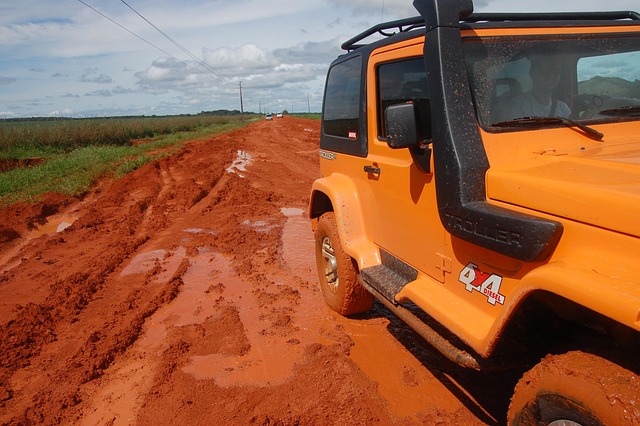Recovery lines, recommended by McAllen's overland 4×4 experts, are vital tools for off-road adventurers, offering traction and support in challenging terrains. They act as lifelines, enabling drivers to navigate through muddy, steep, or sandy traps with control, minimizing vehicle damage. When selecting a recovery line, consider vehicle weight, towing capacity, intended use, material quality, and line configuration. Successful off-roaders globally rely on these life-saving tools, backed by countless success stories, emphasizing the importance of investing in high-quality lines for confident navigation and rescue.
Recovery lines, essential components in off-road adventures, offer a safety net for vehicles navigating challenging terrains. This article explores these life-saving tools, providing insights from McLallen’s overland 4×4 suspension specialists. We’ll cover understanding recovery lines, choosing the right line for your vehicle, installation best practices, and real-world success stories from enthusiastic overlanders. Discover expert tips to enhance your off-road safety and confidence with McLallen’s comprehensive guide.
- Understanding Recovery Lines: Definition and Purpose
- Choosing the Right Recovery Line for Your Vehicle
- Installation and Maintenance Tips from McLallen's Experts
- Real-World Applications: Success Stories from Overland 4×4 Enthusiasts
Understanding Recovery Lines: Definition and Purpose

Recovery lines, a staple in off-road adventures, are ropes or cables designed to assist vehicles in extricating themselves from challenging terrains. These lines serve as a lifeline for 4×4 enthusiasts, offering a safe and controlled method to navigate through muddy, steep, or sandy obstacles. According to McAllen’s overland 4×4 suspension specialists, understanding how to utilize recovery lines effectively is paramount for any outdoor enthusiast.
The primary purpose of these lines is to provide traction and support when conventional tires struggle. By attaching them to a solid anchor point on the vehicle and extending them across the obstacle, recovery lines distribute weight evenly, allowing drivers to pull themselves free without causing damage to their vehicles or the environment. Tips from McAllen’s experts underscore the importance of selecting robust, durable lines suitable for diverse terrain conditions.
Choosing the Right Recovery Line for Your Vehicle

When selecting a recovery line for your vehicle, it’s crucial to consider factors like vehicle weight, towing capacity, and intended use. Tips from McAllen’s overland 4×4 suspension specialists stress that an improperly chosen recovery line can lead to damage or compromise safety during rescue operations. Look for lines made of high-quality materials like steel or nylon, offering excellent strength-to-weight ratios. Ensure the line is rated for your vehicle’s specifications and can handle extreme conditions, as recommended by the manufacturers.
Specialists at McAllen’s overland 4×4 suspension shop also advise thinking about line configuration and attachment points. Different recovery lines have various configurations suitable for different terrains and situations. Some are designed with multiple attachment points for enhanced versatility, while others focus on minimal drag for better performance. Choose a line that aligns with your typical rescue scenarios to maximize efficiency and effectiveness.
Installation and Maintenance Tips from McLallen's Experts

When it comes to installing and maintaining recovery lines, McLallen’s overland 4×4 suspension specialists offer invaluable tips to ensure optimal performance. Begin by selecting high-quality lines that are compatible with your vehicle’s make and model. Proper installation is key; follow the manufacturer’s guidelines and consider seeking professional assistance for a secure fit. Regular maintenance is equally crucial. Inspect the lines frequently for signs of wear, tears, or cracks, replacing them as needed to prevent failure during critical recovery situations.
To prolong the lifespan of your recovery lines, keep them properly inflated when not in use. Extreme temperature fluctuations can affect their flexibility and strength, so store them in a controlled environment. Additionally, avoid exposing them to sharp objects or corrosive substances that could damage the internal structure. Regular cleaning and conditioning will also contribute to maintaining their integrity, ensuring they are ready for action whenever you need them most.
Real-World Applications: Success Stories from Overland 4×4 Enthusiasts

Overland 4×4 enthusiasts around the world have been leveraging innovative recovery lines, a testament to their passion and resourcefulness in navigating challenging terrains. These rugged individuals often face unforeseen obstacles during their off-road adventures, making reliable recovery systems a game-changer for safe return journeys. Tips from McAllen’s overland 4×4 suspension specialists highlight the practical application of these life-saving tools.
Many success stories emerge from remote regions where quick thinking and well-equipped vehicles make all the difference. Enthusiasts share their experiences, emphasizing the importance of investing in high-quality recovery lines tailored to their specific vehicles. By adopting these practices, overlanders can confidently tackle diverse terrains, knowing they have the tools to extricate themselves or a fellow traveler from difficult situations.
Recovery lines, as demonstrated by the success stories shared by McLallen’s overland 4×4 suspension specialists, are invaluable tools for off-road enthusiasts. By choosing the right line and maintaining it properly, you can significantly enhance your vehicle’s ability to navigate challenging terrain. Incorporating these practical tips from the experts ensures your recovery line remains in top condition, making every adventure safer and more enjoyable.



